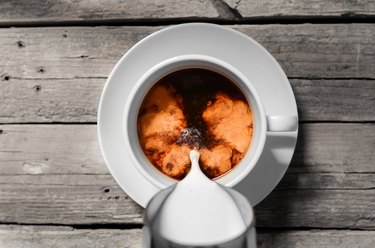
Caffeine can be a quick pick-me-up or give you an energy boost to start your day. But your body can eventually depend on it. Cutting back can lead to a caffeine withdrawal headache and other unpleasant symptoms.
Caffeine withdrawal symptoms typically begin about 24 hours after you stop consuming it and can last for three days or more, according to the Alcohol and Drug Foundation. In addition to headache, you might experience blood pressure changes (increased or decreased), tremors, flu-like symptoms, constipation, joint stiffness, abdominal pain and caffeine withdrawal nausea.
Video of the Day
Video of the Day
Read more: Long-Term Effects of Caffeine
Biology of a Caffeine Headache
Caffeine is a neurological system stimulant, which can provide energy and increase alertness. It also reduces blood flow to the brain, which means that caffeine withdrawal increases blood flow, and that can result in headache.
According to a 2017 article published by Journal of Psychology & Psychotherapy, excessive caffeine consumption can lead to a mild type of drug dependence. As such, cutting back on caffeine leads to withdrawal symptoms including headache, sleepiness and irritability. Caffeine withdrawal can also make you dizzy.
The exact amount of caffeine that's consumed daily, from food, beverages or medication, and the steepness of your reduction in consumption determine how severe and likely a withdrawal headache is.
Reduce Intake Gradually
A caffeine withdrawal headache from moderate amounts of caffeine is rare; those who regularly consume 500 milligrams or more of caffeine per day, which is equal to about five cups of coffee, are more likely to experience the painful condition, according to the Cleveland Clinic.
For that reason, it's often necessary to gradually reduce how much caffeine you consume to help your body adjust to the changes. For example, reduce your coffee intake to four cups, wait a few days and then reduce it to three cups. Once you've reduced your intake, drink caffeine in moderation, which is usually about 200 milligrams per day.
Moderate caffeine intake can help reduce the likelihood of a withdrawal headache should you choose to limit your intake on a given day for whatever the reason.
Keep Your Consumption Consistent
If you choose to keep caffeine in your daily diet, be consistent in your consumption, recommends the Cleveland Clinic. Even a small variation can lead to a withdrawal headache.
This means that you shouldn't consume 500 milligrams one day and only 200 milligrams the next day because this difference can lead to withdrawal symptoms on the days when you're consuming less. Educate yourself about how much caffeine is contained in the things you eat and drink and then create a daily diet that keeps your intake the same.
Caffeine Withdrawal Treatment
Taking a nap or getting a good night's rest can help ease a caffeine withdrawal headache. Staying well-hydrated can also help with caffeine withdrawal treatment, so drink plenty of water.
If you're intentionally reducing your caffeine intake, talk to your doctor about over-the-counter pain relievers. The ones that contain small amounts of caffeine might help ease the transition to consuming less caffeine each day.